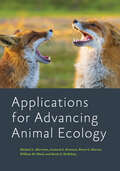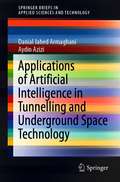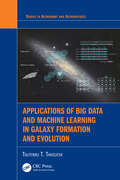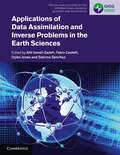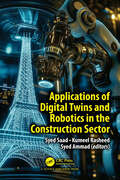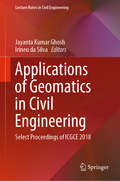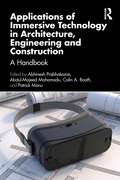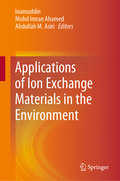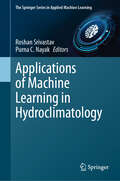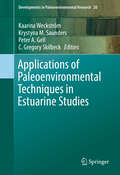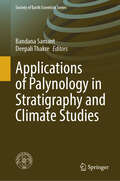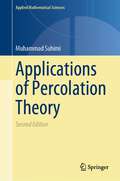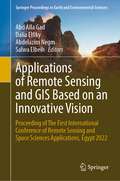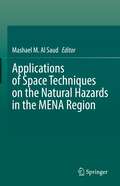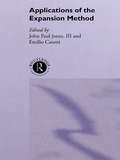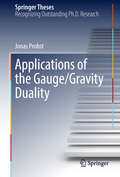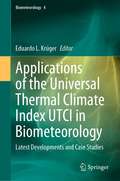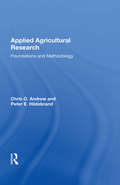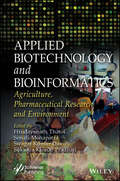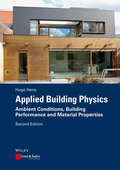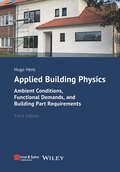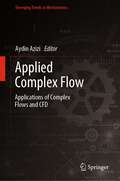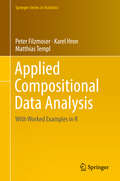- Table View
- List View
Applications for Advancing Animal Ecology (Wildlife Management and Conservation)
by Michael L. Morrison Bruce G. Marcot Leonard A. Brennan William M. Block Kevin S. McKelveyPractical guidance for wildlife professionals working to improve study design, data analysis, and the application of results to habitat and population management.Despite major advances in sampling techniques and analytical methods, many animal ecologists conduct research that is primarily relevant to a specific time and place. They also tend to focus more on the statistical analyses and nuances of modeling than actual study design. Arguing that studies of animal ecology should always begin with a focus on the behaviors and characteristics of individual organisms, including how they form into distinct biological populations, Applications for Advancing Animal Ecology takes a fresh and critical look at the field. Building from its companion volume, Foundations for Advancing Animal Ecology, this practical book presents readers with the principal methods used to observe animal behavior. Teaching them to assess resource abundance categories of species-environmental relationships models, it also explores• major aspects of measuring animal habitat: what to measure and how to measure it;• common sampling and estimation methods to assess population parameters;• when to measure and how to analyze data;• problems that will confront ecologists in the coming years—and how to gather information to adequately address them; and• how the experimental approach can be used to advance the science of animal ecology.Throughout the book, the authors stress the importance of speaking a common and well-defined language. Avoiding vague and misleading terminology, they assert, will help ecologists translate science into meaningful and lasting actions in the environment. Taking the perspective of the organism of interest in developing concepts and applications, the authors always keep the potentially biased human perspective in focus. They also provide a selection of suggested research projects, cautions, and caveats. A major advancement in understanding the factors underlying wildlife–habitat relationships, Applications for Advancing Animal Ecology will be an invaluable resource to natural resource management professionals and practitioners, including state and federal agencies, non-governmental organizations, and environmental consultants.
Applications of Artificial Intelligence in Tunnelling and Underground Space Technology (SpringerBriefs in Applied Sciences and Technology)
by Aydin Azizi Danial Jahed ArmaghaniThis book covers the tunnel boring machine (TBM) performance classifications, empirical models, statistical and intelligent-based techniques which have been applied and introduced by the researchers in this field. In addition, a critical review of the available TBM performance predictive models will be discussed in details. Then, this book introduces several predictive models i.e., statistical and intelligent techniques which are applicable, powerful and easy to implement, in estimating TBM performance parameters. The introduced models are accurate enough and they can be used for prediction of TBM performance in practice before designing TBMs.
Applications of Big Data and Machine Learning in Galaxy Formation and Evolution (Series in Astronomy and Astrophysics)
by Tsutomu T. TakeuchiAs investigations into our Universe become more complex, in-depth, and widespread, galaxy surveys are requiring state-of-the-art data scientific methods to analyze them. This book provides a practical introduction to big data in galaxy formation and evolution, introducing the astrophysical basics, before delving into the latest techniques being introduced to astronomy and astrophysics from data science. This book helps translate the cutting-edge methods into accessible guidance for those without a formal background in computer science. It is an ideal manual for astronomers and astrophysicists, in addition to graduate students and postgraduate students in science and engineering looking to learn how to apply data-science to their research.Key Features: Introduces applications of data-science methods to the exciting subject of galaxy formation and evolution Provides a practical guide to understanding cutting-edge data-scientific methods, as well as classical astrostatistical methods Summarises a vast range of statistical and informatics methods in one volume, with concrete applications to astrophysics
Applications of Data Assimilation and Inverse Problems in the Earth Sciences (Special Publications of the International Union of Geodesy and Geophysics #5)
by Dylan Jones Alik Ismail-Zadeh Fabio Castelli Sabrina SanchezMany contemporary problems within the Earth sciences are complex, and require an interdisciplinary approach. This book provides a comprehensive reference on data assimilation and inverse problems, as well as their applications across a broad range of geophysical disciplines. With contributions from world leading researchers, it covers basic knowledge about geophysical inversions and data assimilation and discusses a range of important research issues and applications in atmospheric and cryospheric sciences, hydrology, geochronology, geodesy, geodynamics, geomagnetism, gravity, near-Earth electron radiation, seismology, and volcanology. Highlighting the importance of research in data assimilation for understanding dynamical processes of the Earth and its space environment and for predictability, it summarizes relevant new advances in data assimilation and inverse problems related to different geophysical fields. Covering both theory and practical applications, it is an ideal reference for researchers and graduate students within the geosciences who are interested in inverse problems, data assimilation, predictability, and numerical methods.
Applications of Digital Twins and Robotics in the Construction Sector
by Syed Saad Syed Ammad Kumeel RasheedThis book provides insights to the lay person as well as the experts who are actively enabling these changes in the construction industry. The book explores digital twins and robots in the construction sector, and how they are revolutionizing this field. It comprises chapters that begin with the basics before going upstream. Digital Twins are important in the planning and design of projects where, real-time simulation, visualization and data-driven decision-making are done. Furthermore, robotics play a significant role in on-site execution, thus automating construction operations, and guaranteeing accuracy and safety. The book discusses the harmony of digital twinning and robotics, showing that these two are complementary with regard to enhancing efficiencies on-site, in monitoring progress and live control.Applications of Digital Twins and Robotics in the Construction Sector covers the current applications of these technologies and forecasts future applications, exposing readers to breakthrough innovations transforming this field. It aims inform all readers, expert or simply interested and inquisitive about digital twins and construction robots’ transformation.
Applications of Geomatics in Civil Engineering: Select Proceedings of ICGCE 2018 (Lecture Notes in Civil Engineering #33)
by Jayanta Kumar Ghosh Irineu Da SilvaThis book comprises select proceedings of the First International Conference on Geomatics in Civil Engineering (ICGCE 2018). This book presents latest research on applications of geomatics engineering in different domains of civil engineering, like structural engineering, geotechnical engineering, hydraulic and water resources engineering, environmental engineering and transportation engineering. It also covers miscellaneous applications of geomatics in a wide range of technical and societal problems making use of geospatial information, engineering principles, and relational data structures involving measurement sciences. The book proves to be very useful for the scientific and engineering community working in the field of geomatics and geospatial technology.
Applications of Immersive Technology in Architecture, Engineering and Construction: A Handbook (Spon Research)
by Colin A. Booth Patrick Manu Abdul-Majeed Mahamadu Abhinesh PrabhakaranThis edited book addresses a gap in literature by advancing current understandings of the applications of immersive technology within the architecture, engineering and construction (AEC) sector.Globally, the architecture, engineering and construction (AEC) sector makes an enormous contribution to the socio-economic development of nations, which is primarily evidenced by its creation/provision of the built environment. The sector has, however, often been criticised for inefficiencies, waste and diverse forms of adverse impacts that are associated with the lifecycle of the provision of built assets – design, construction, operations and maintenance and end-of-life phases. Over the years, the inefficiencies, waste and adverse impacts have often been a catalyst for calls and initiatives to transform the AEC sector. The advent of the fourth industrial revolution (commonly referred to as, ‘Industry 4.0’), which entails the automation and digitalisation of production, presents opportunities to leverage emerging technologies to improve the image and productivity of the sector. Prominent among the emerging technologies in the Industry 4.0 era is that of immersive technology, which includes virtual reality, mixed reality and augmented reality. The capability of immersive technology to deliver beneficial impacts for multiple construction sector stakeholders throughout the construction lifecycle has been acknowledged within the industry and this continues to stimulate interest amongst practitioners, policymakers and researchers. Despite this phenomenon, at present there is no dedicated compendium of research-informed text that focusses on the multifaceted applications of immersive technology throughout the lifecycle of the provision of built assets right from concept design to end-of-life.This book thus addresses this gap in literature by advancing current understanding of the applications of immersive technology within the AEC industry. Readers will understand how the technologies are applied, the resulting array of impacts including benefits, drawbacks, challenges and future directions for applications, research and development.
Applications of Ion Exchange Materials in the Environment
by Inamuddin Abdullah M. Asiri Mohd Imran AhamedThis book presents the applications of ion-exchange materials in the area of environmental analysis and treatment. It includes chapters on applications of organic, inorganic and composite ion exchange materials and hexacyanoferrates in various fields such as chemical and biochemical separations, water purification, removal of harmful impurities, dyes and cationic and anionic complexes. This title is a highly valuable source of knowledge on ion-exchange materials and their applications suitable for postgraduate students and researchers but also to industrial R&D specialists in chemistry, chemical, and biochemical technology. Additionally, this book will provide an in-depth knowledge of ion-exchange column and operations suitable for engineers and industrialists.
Applications of Machine Learning in Hydroclimatology (The Springer Series in Applied Machine Learning)
by Roshan Srivastav Purna C. NayakApplications of Machine Learning in Hydroclimatology is a comprehensive exploration of the transformative potential of machine learning for addressing critical challenges in water resources management. The book explores how artificial intelligence can unravel the complexities of hydrological systems, providing researchers and practitioners with cutting-edge tools to model, predict, and manage these systems with greater precision and effectiveness. It thoroughly examines the modeling of hydrometeorological extremes, such as floods and droughts, which are becoming increasingly difficult to predict due to climate change. By leveraging AI-driven methods to forecast these extremes, the book offers innovative approaches that enhance predictive accuracy. It emphasizes the importance of analyzing non-stationarity and uncertainty in a rapidly evolving climate landscape, illustrating how statistical and frequency analyses can improve hydrological forecasts. Moreover, the book explores the impact of climate change on flood risks, drought occurrences, and reservoir operations, providing insights into how these phenomena affect water resource management. To provide practical solutions, the book includes case studies that showcase effective mitigation measures for water-related challenges. These examples highlight the use of machine learning techniques such as deep learning, reinforcement learning, and statistical downscaling in real-world scenarios. They demonstrate how artificial intelligence can optimize decision-making and resource management while improving our understanding of complex hydrological phenomena. By utilizing machine learning architectures tailored to hydrology, the book presents physics-guided models, data-driven techniques, and hybrid approaches that can be used to address water management issues. Ultimately, Applications of Machine Learning in Hydroclimatology empowers researchers, practitioners, and policymakers to harness machine learning for sustainable water management. It bridges the gap between advanced AI technologies and hydrological science, offering innovative solutions to tackle today's most pressing challenges in water resources.
Applications of Palaeontology
by Robert Wynn JonesPalaeontology, the scientific study of fossils, has developed from a descriptive science to an analytical science used to interpret relationships between earth and life history. This book provides a comprehensive and thematic treatment of applied palaeontology, covering the use of fossils in the ordering of rocks in time and in space, in biostratigraphy, palaeobiology and sequence stratigraphy. Robert Wynn Jones presents a practical workflow for applied palaeontology, including sample acquisition, preparation and analysis, and interpretation and integration. He then presents numerous case studies that demonstrate the applicability and value of the subject to areas such as petroleum, mineral and coal exploration and exploitation, engineering geology and environmental science. Specialist applications outside of the geosciences (including archaeology, forensic science, medical palynology, entomopalynology and melissopalynology) are also addressed. Abundantly illustrated and referenced, Applications of Palaeontology provides a user-friendly reference for academic researchers and professionals across a range of disciplines and industry settings.
Applications of Paleoenvironmental Techniques in Estuarine Studies (Developments in Paleoenvironmental Research #Volume 20)
by Kaarina Weckström Krystyna M. Saunders Peter A. Gell C. Gregory SkilbeckThe aim of this edited volume is to introduce the scientific community to paleoenvironmental studies of estuaries, to highlight the types of information that can be obtained from such studies, and to promote the use of paleoenvironmental studies in estuarine management. <P><P> Readers will learn about the the application of different paleoecological approaches used in estuaries that develop our understanding of their response to natural and human influences. Particular attention is given to the essential steps required for undertaking a paleoecological study, in particular with regard to site selection, core extraction and chronological techniques, followed by the range of indicators that can be used. A series of case studies are discussed in the book to demonstrate how paleoecological studies can be used to address key questions, and to sustainably manage these important coastal environments in the future. This book will appeal to professional scientists interested in estuarine studies and/or paleoenvironmental research, as well as estuarine managers who are interested in the incorporation of paleoenvironmental research into their management programs.
Applications of Palynology in Stratigraphy and Climate Studies (Society of Earth Scientists Series)
by Bandana Samant Deepali ThakreThis book highlights the importance of palynology in understanding floral biodiversity, paleoclimate and depositional environments in deep time and recent sediments. It includes contributions from renowned Indian palynologists who work on the applied aspects of palynology. The book focuses on the significance of palynology in solving various geological problems, ranging from the Precambrian to the Recent. This book will be useful to graduate and postgraduate students, researchers, and academicians working in geology and botany, as well as international researchers interested in palynological research work in India.
Applications of Percolation Theory (Applied Mathematical Sciences #213)
by Muhammad SahimiThe first edition of this book was published in 1994. Since then considerable progress has been made in both theoretical developments of percolation theory, and in its applications. The 2nd edition of this book is a response to such developments. Not only have all of the chapters of the 1st edition been completely rewritten, reorganized, and updated all the way to 2022, but also 8 new chapters have been added that describe extensive new applications, including biological materials, networks and graphs, directed percolation, earthquakes, geochemical processes, and large-scale real world problems, from spread of technology to ad-hoc mobile networks.
Applications of Remote Sensing and GIS Based on an Innovative Vision: Proceeding of The First International Conference of Remote Sensing and Space Sciences Applications, Egypt 2022 (Springer Proceedings in Earth and Environmental Sciences)
by Abdelazim Negm Abd Alla Gad Dalia Elfiky Salwa ElbeihThis book covers various aspects of remote sensing and geographic information systems, from the perspective of earth and environmental sciences. The theme of applications of remote sensing and geographic information systems for the purposes of sustainable development highlights the innovative usage of space imaged spectral data in soil characterization. This book merges the selected contributions to the First International Conference of Remote Sensing and Space Sciences Applications (Egypt 2022) aiming to promote the latest findings on the development of Space Technologies and Applications.
Applications of Space Techniques on the Natural Hazards in the MENA Region
by Mashael M. Al SaudThis book introduces a comprehensive understanding in the use of space techniques in natural hazards and risk management in the MENA Region. The book is based on different case-studies from 25 MENA countries, and will be useful in highlighting the issues from all aspects. In recent years the number of natural hazard events has increased in the MENA Region. This is exacerbated by the changing climate and extreme climate events, as well as a large increase in the population in this area. Disastrous events occur on a yearly basis characterized by a vulnerability of physical processes. Floods, earthquakes, and mass movement result in severe damage to property and livelihoods, and have devastating effects upon the environment. These events cause severe financial losses, which on an annual basis, can exceed millions of dollars. The predication, assessment and monitoring approaches remain inadequate in managing these hazards and in mitigating their impacts, but with the development of space techniques and geo-information systems, these situations can now be better managed. The miscellany of satellite images, with different spatial and temporal resolutions, enable the detection of terrain features and provide indications of potential natural risks. This book will of interest to stakeholders, including field experts, academics, researchers and decision makers.
Applications of the Expansion Method
by John Paul JonesFirst published in 2004. Routledge is an imprint of Taylor & Francis, an informa company.
Applications of the Gauge/Gravity Duality (Springer Theses)
by Jonas ProbstMany open questions in Theoretical Physics pertain to strongly interacting quantum systems such as the quark-gluon plasma (QGP) produced in heavy-ion collisions or the strange-metal phase observed in many high-temperature superconductors. These systems are notoriously difficult to study using traditional methods such as perturbation theory, but the gauge/gravity duality offers a successful alternative approach, which maps strongly interacting quantum gauge theories to computationally tractable, classical gravity theories. This book begins with a pedagogical introduction to how the duality can be used to extract transport properties of quantum systems from their gravity dual. It then presents new results on hydrodynamic transport in strongly interacting quantum fluids, providing strong evidence that the Haack-Yarom identity between second-order transport coefficients holds for all fluids with a classical gravity dual and may be a universal feature of all strongly coupled quantum fluids such as the QGP. Newly derived Kubo formulae, expressing transport coefficients in terms of quantum correlators, hold independently of the duality. Lastly, the book discusses new results on magnetic impurities in strongly correlated metals, including the first dual gravity description of an inter-impurity coupling, crucial for the quantum criticality underlying the strange-metal phase.
Applications of the Universal Thermal Climate Index UTCI in Biometeorology: Latest Developments and Case Studies (Biometeorology #4)
by Eduardo L. KrügerThis book introduces the UTCI (Universal Thermal Climate Index) and summarizes progress in this area. The UTCI was developed as part of the European COST Action Program and first announced to the scientific community in 2009. Since then, a decade has followed of applicability tests and research results, as well as knowledge gained from applying the UTCI in human adaptation and thermal perception. These findings are of interest to researchers in the interdisciplinary areas of biometeorology, climatology and urban planning. The book summarizes this progress, discussing the limitations found and provides pointers to future developments. It also discusses UTCI applications in the areas of human biometeorology and urban planning including possibilities of using UTCI and similar indices in climate-responsive urban planning. The book’s message is illustrated with many case studies from the real world.Chapter 10 is available open access under a Creative Commons Attribution 4.0 International License via link.springer.com.
Applied Agricultural Research: Foundations And Methodology
by Chris O AndrewThe desire to resolve problems through pragmatic observation, systematic evaluation, and coordinated action persists with each new generation of researchers. A timeless task that bears individual, social, and often cultural characteristics, problem resolution is essentially an experiential process. Routine and methodology can enhance both its proce
Applied Biotechnology and Bioinformatics: Agriculture, Pharmaceutical Research and Environment
by Swagat Kumar Das Hrudayanath Thatoi Sonali Mohapatra Sukanta Kumar PradhanThis comprehensive reference book discusses the convergent and next-generation technologies for product-derived applications relevant to agriculture, pharmaceuticals, nutraceuticals, and the environment. The field of modern biotechnology is a multidisciplinary and groundbreaking area of biology that includes several cutting-edge methods due to developments in forensics and molecular modeling. Bioinformatics is a full-fledged multidisciplinary field that combines advances in computer and information technology. Numerous applications of bioinformatics—primarily in the areas of gene and protein identification, structural and functional prediction, drug development and design, folding of genes and proteins and their complexity, vaccine design, and organism identification—have contributed to the advancement of biotechnology. Biotechnology is also essential to crop improvement in agriculture because it allows genes to transfer across plants to increase traits such as disease resistance and yield. It also plays a broad role in healthcare, including genetic testing, gene therapy, pharmacogenomics, and drug development. Bioremediation and biodegradation, using microbial technologies to clean up environmental contamination, waste management technologies, and the conversion of organic waste to biofuels. Bioinformatics plays a critical role in analyzing different types of data created by high-throughput research methods—such as genomic, transcriptomic, and proteomic datasets—that are useful in addressing various problems related to disease management, clean environment, alternative energy sources, agricultural productivity, and more. Audience The book will interest biotechnology researchers and bioinformatics professionals working in the areas of applied biotechnology, bioengineering, biomedical sciences, microbiology, agriculture and environmental sciences.
Applied Building Physics: Ambient Conditions, Building Performance and Material Properties
by Hugo S. HensBad experiences with construction quality, the energy crises of 1973 and 1979,complaints about `sick buildings?, thermal, acoustical, visual and olfactory discomfort, the need for good air quality, the move towards more sustainability ? all these have accelerated the development of a field that, for a long time, was hardly more than an academic exercise: building physics. The discipline embraces domains such as heat and mass transfer, building acoustics, lighting, indoor environmental quality and energy efficiency. In some countries, fire safety is also included. Through the application of physical knowledge and its combination with information coming from other disciplines, the field helps to understand the physical phenomena governing building parts, building envelope, whole building and built environment performance, although for the last the wording `urban physics? is used. Building physics has a real impact on performance-based building design. This volume on `Applied Building Physics? discusses the heat, air and moisture performance metrics that affect building design, construction and retrofitting.
Applied Building Physics: Ambient Conditions, Functional Demands, and Building Part Requirements
by Hugo S. HensWhile the first volume on building physics deals with the physical principles of heat, air and moisture behaviour of buildings, building structures and components, this second volume on applied building physics focuses on the question of what the desired performance of buildings consists of. To achieve this, knowledge of the external environmental effects and the internal live loads to which buildings are subjected is a necessary first step. Subsequently, the performance requirements and the physical correspondences are deepened with the determination of their physical parameters, at the levels of buildings, building structures and building components. Compared to the second edition, the discussion of criteria is not limited to thermal comfort, but also includes acoustic, visual and olfactory aspects. Likewise, the indoor air quality is considered in a broader way. Analyses and calculations result in sustainable buildings with a comfortable indoor climate from functional and durable building constructions. Compared to the second edition, the text for the third edition has been reorganised, corrected, revised and expanded where appropriate. A useful appendix for quick reference contains standard values of material properties for a wide range of building materials. The analyses and calculations described in this book result in sustainable buildings made of functional and durable building constructions, with comfortable and healthy indoor climate and air quality. Compared to the second edition the text in this third edition has been reshuffled, corrected, reworked and extended where appropriate.
Applied Climatology: Principles and Practice
by Allen Perry Dr Russell Thompson Russell Thompson'Big freeze' conditions, storms, severe flooding, droughts, and heatwaves - recent extremes in weather, with their resultant physical, economic and human losses, highlight the vulnerability of society to changes in the atmosphere. Atmospheric pollution, urbanization, natural atmospheric disasters are causing dramatic changes in climatic environments.Applied Climatology examines the effects of climate on physical, biological and cultural environments. Specialist contributors from Europe, North America and Australasia examine the impacts of changing climates on the functioning and development of physical biological environments including glaciers, water resources, landforms, soils, vegetation and animals.Weather and climate effects day-to-day activities and lifestyles from the clothes we wear to the buildings we design, and the food and energy we produce. This book focusses on the relationship between climate and a wide range of human activities and responses relating to health and comfort, building design, transport systems, agriculture and fisheries, tourism and social, industrial and legal issues.Climate-environment relationships and impacts on human activities are predicted to change dramatically if global warming accelerates at the rates currently proposed. Applied Climatology examines the characteristics and consequences of the changing global climate and considers the future for both natural and human environments.
Applied Complex Flow: Applications of Complex Flows and CFD (Emerging Trends in Mechatronics)
by Aydin AziziThis book presents improved numerical techniques and applied computer-aided simulations as a part of emerging trends in mechatronics in all areas related to complex fluids, with particular focus on using a combination of modeling, theory, and simulation to study systems that are complex due to the rheology of fluids (i.e., ceramic pastes, polymer solutions and melts, colloidal suspensions, emulsions, foams, micro-/nanofluids, etc.) and multiphysics phenomena in which the interactions of various effects (thermal, chemical, electric, magnetic, or mechanical) lead to complex dynamics. The areas of applications span materials processing, manufacturing, and biology.
Applied Compositional Data Analysis: With Worked Examples In R (Springer Series in Statistics)
by Peter Filzmoser Matthias Templ Karel HronThis book presents the statistical analysis of compositional data using the log-ratio approach. It includes a wide range of classical and robust statistical methods adapted for compositional data analysis, such as supervised and unsupervised methods like PCA, correlation analysis, classification and regression. In addition, it considers special data structures like high-dimensional compositions and compositional tables. The methodology introduced is also frequently compared to methods which ignore the specific nature of compositional data. It focuses on practical aspects of compositional data analysis rather than on detailed theoretical derivations, thus issues like graphical visualization and preprocessing (treatment of missing values, zeros, outliers and similar artifacts) form an important part of the book. Since it is primarily intended for researchers and students from applied fields like geochemistry, chemometrics, biology and natural sciences, economics, and social sciences, all the proposed methods are accompanied by worked-out examples in R using the package robCompositions.
